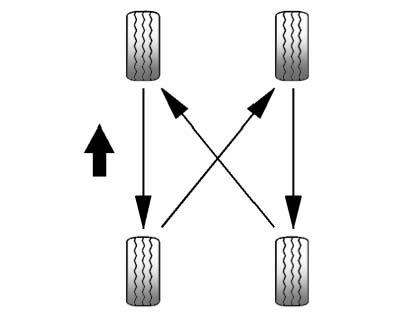Chevrolet Cruze Owners Manual: Tire Rotation
Tires should be rotated every 12 000 km (7,500 mi).
Tires are rotated to achieve a uniform wear for all tires. The first rotation is the most important.
Anytime unusual wear is noticed, rotate the tires as soon as possible, check for proper tire inflation pressure, and check for damaged tires or wheels. If the unusual wear continues after the rotation, check the wheel alignment.

Use this rotation pattern when rotating the tires.
Do not include the compact spare tire in the tire rotation.
Adjust the front and rear tires to the recommended inflation pressure on the Tire and Loading Information label after the tires have been rotated.
Reset the Tire Pressure Monitor System.
Check that all wheel nuts are properly tightened.
WARNING
Rust or dirt on a wheel, or on the parts to which it is fastened, can make wheel nuts become loose after time. The wheel could come off and cause an accident. When changing a wheel, remove any rust or dirt from places where the wheel attaches to the vehicle. In an emergency, a cloth or a paper towel can be used; however, use a scraper or wire brush later to remove all rust or dirt.
Lightly coat the center of the wheel hub with wheel bearing grease after a wheel change or tire rotation to prevent corrosion or rust build-up. Do not get grease on the flat wheel mounting surface or on the wheel nuts or bolts.
 Tire Inspection
Tire Inspection
We recommend that the tires, including the spare tire, if the vehicle has one,
be inspected for signs of wear or damage at least once a month.
Replace the tire if:
Х The indicators at three or mor ...
 When It Is Time for New Tires
When It Is Time for New Tires
Factors such as maintenance, temperatures, driving speeds, vehicle loading, and
road conditions affect the wear rate of the tires.
Treadwear indicators are one way to tell when it is time for new ...
Other materials:
Drive Belt Replacement
Special Tools
EN 6349 Locking Pin
For equivalent regional tools, refer to Special Tools.
Removal Procedure
Open the hood.
Remove the power steering pump belt. Refer to Power Steering Pump Belt
Replacement.
Raise the vehicle by its full height. Refer to Lifting and Jacking the
Vehicl ...
Rear Window Defogger Description and Operation
Rear Window Defogger System Components
The rear window defogger system consists of the following components:
HVAC Control Module
HVAC Control Head
Rear Window Defogger Relay
Rear Defogger Grid
F28UA 40A Fuse
Rear Window Defogger Operation
The rear defog control system utilizes a sin ...
Rear Bumper Fascia Guide Replacement
Preliminary Procedure
Remove the rear bumper fascia. Refer to Rear Bumper Fascia Replacement.
Rear Bumper Fascia Guide Rivet (Qty: 4)
Special Tools
BO-594-A Hand Rivet Tongs
For equivalent regional tools, refer to Special Tools.
Rear Bumper Fascia Guide
Rear Bumper Fascia Inner ...
